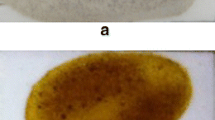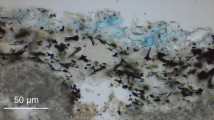Abstract
The aim of this work is to gain a further insight into the knowledge of the production process of lustre-decorated ancient majolicas. Lustre is a sophisticated technique employed in the decoration of majolicas as used in central Italy during the Renaissance period. It consists of a beautiful iridescent gold or ruby-red thin metallic film, containing silver, copper and other substances and obtained in a reducing atmosphere on a previously glazed ceramic. Nowadays, it is not possible to replicate the outstanding results obtained by the ancient ceramicists, since the original recipes were lost. It is quite interesting to study lustre-production technology by means of analytical techniques now employed for advanced research on materials (XRD, ETAAS, ICP-OES, TEM-EDX-SAED and UV-Vis). In this work, we have focussed our attention on ceramic fragments decorated with both gold and ruby-red lustres, which were difficult to obtain due to complex reduction conditions required and which were a prerogative of Gubbio production. The two lustre colours differ in their chemical composition as well in their nanostructure. The presence of bismuth was disclosed and it was ascertained to be a distinctive feature of the Italian production.
Similar content being viewed by others
References
A. Caiger-Smith: Luster Pottery: Technique, Tradition and Innovation in Islam and the Western World (Faber and Faber, London 1985) p. 197
C. Piccolpasso: Li Tre Libri dell’Arte del Vasaio, 1557 (Edizioni all’insegna del Giglio, Firenze 1976)
J. Pèrez-Arantegui, J. Molera, A. Larrea, T. Pradell, M. Vendrell-Saz, I. Borgia, B. Brunetti, F. Cariati, P. Fermo, M. Mellini, A. Sgamellotti, C. Viti: J. Am. Ceram. Soc. 84, 442 (2001)
W.D. Kingery, P.B. Vandiver: in Ceramic Masterpieces: Art, Structure and Technology (The Free Press, New York 1986) p. 111
G. Padeletti, P. Fermo: Appl. Phys. A 76, 515 (2003)
G. Padeletti, P. Fermo: Appl. Phys. A 77, 125 (2003)
G. Padeletti, P. Fermo: Appl. Phys. A, in press
A. Galli, M. Martini, E. Sibillia, G. Padeletti, P. Fermo: Appl. Phys. A, in press
G. Padeletti, P. Fermo. S. Gilardoni: MRS Symp. Proc. ‘Material Issues in Art and Archaeology VI’ 712, 383 (2002)
P. Fermo, F. Cariati, C. Cipriani, M. Canetti, G. Padeletti, B. Brunetti, A. Sgamellotti: Appl. Surf. Sci. 185, 309 (2002)
J. Molera, M. Mesquida, J. Pèrez-Arantegui, T. Pradell, M. Vendrell: Archaeometry 43, 445 (2001)
M.S. Tite, I. Freestone, R. Mason, J. Molera, M. Vendrell-Saz: Archaeometry 40, 241 (1998)
F. Colao, R. Fantoni, V. Lazic, V. Spizzichino: Spectrochim. Acta B 57, 1219 (2002)
Author information
Authors and Affiliations
Corresponding author
Additional information
PACS
78.67.Bf; 81.05.Je; 68.37.Lp; 68.37.Hk; 68.90.+g
Rights and permissions
About this article
Cite this article
Padeletti, G., Fermo, P. Production of gold and ruby-red lustres in Gubbio (Umbria, Italy) during the Renaissance period. Appl. Phys. A 79, 241–245 (2004). https://doi.org/10.1007/s00339-004-2513-5
Received:
Accepted:
Published:
Issue Date:
DOI: https://doi.org/10.1007/s00339-004-2513-5




